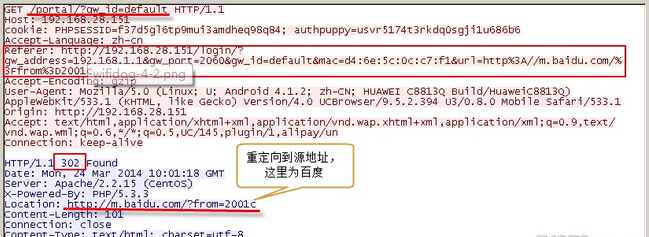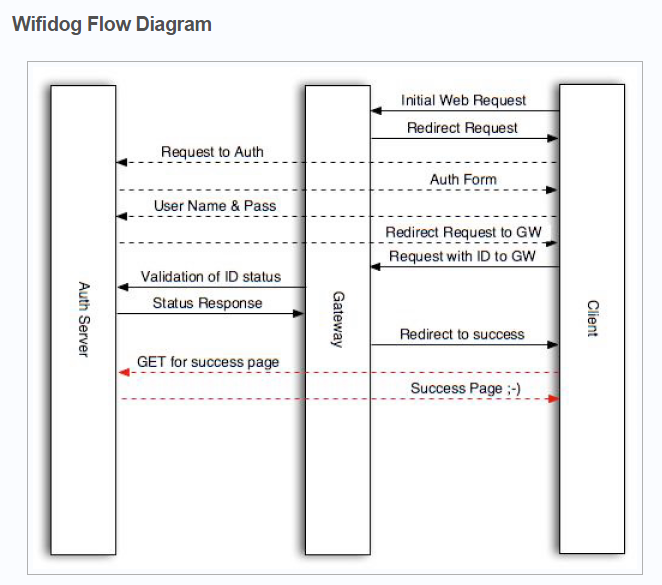在上一篇《wifidog 源码处分析(3)》的流程结束后,接入设备的浏览器重定向至 路由器 上 wifidog 的 http 服务(端口 2060) /wifidog/auth 上(且携带了 认证服务器 为此接入设备分配的 token),本篇就是从 wifidog 接收到 /wifidog/auth 的访问后的 校验流程。
根据《wifidog 源码初分析(2)》中描述的,在 wifidog 启动 http 服务前,注册了一个针对访问路径 /wifidog/auth 的回调,如下:
httpdAddCContent(webserver, "/wifidog", "about", 0, NULL, http_callback_about);
httpdAddCContent(webserver, "/wifidog", "status", 0, NULL, http_callback_status);
// 注册了针对 /wifidog/auth 的访问回调 http_callback_auth
httpdAddCContent(webserver, "/wifidog", "auth", 0, NULL, http_callback_auth);
这样对于 接入设备(or 客户端) 重定向过来的 /wifidog/auth 就进入了 http_callback_auth 函数中,如下:
http_callback_auth(httpd *webserver, request *r)
{
t_client *client;
httpVar * token;
char *mac;
// 1, 获取条件参数中的 logout 值
httpVar *logout = httpdGetVariableByName(r, "logout");
// 2, 获取条件参数中的 token 值
if ((token = httpdGetVariableByName(r, "token"))) {
/* They supplied variable "token" */
// 3, 可以看到, 这里要求必须能够通过 ARP 协议获取到 接入设备 的 MAC 地址
if (!(mac = arp_get(r->clientAddr))) {
/* We could not get their MAC address */
debug(LOG_ERR, "Failed to retrieve MAC address for ip %s", r->clientAddr);
send_http_page(r, "WiFiDog Error", "Failed to retrieve your MAC address");
} else {
/* We have their MAC address */
LOCK_CLIENT_LIST();
// 4, 检查该客户端(接入设备)是否已经在 wifidog 维护的接入客户端列表中
if ((client = client_list_find(r->clientAddr, mac)) == NULL) {
debug(LOG_DEBUG, "New client for %s", r->clientAddr);
client_list_append(r->clientAddr, mac, token->value);
} else if (logout) {
// 5, 退出处理
t_authresponse authresponse;
s_config *config = config_get_config();
unsigned long long incoming = client->counters.incoming;
unsigned long long outgoing = client->counters.outgoing;
char *ip = safe_strdup(client->ip);
char *urlFragment = NULL;
t_auth_serv *auth_server = get_auth_server();
fw_deny(client->ip, client->mac, client->fw_connection_state);
client_list_delete(client);
debug(LOG_DEBUG, "Got logout from %s", client->ip);
/* Advertise the logout if we have an auth server */
if (config->auth_servers != NULL) {
UNLOCK_CLIENT_LIST();
auth_server_request(&authresponse, REQUEST_TYPE_LOGOUT, ip, mac, token->value,
incoming, outgoing);
LOCK_CLIENT_LIST();
/* Re-direct them to auth server */
debug(LOG_INFO, "Got manual logout from client ip %s, mac %s, token %s"
"- redirecting them to logout message", client->ip, client->mac, client->token);
safe_asprintf(&urlFragment, "%smessage=%s",
auth_server->authserv_msg_script_path_fragment,
GATEWAY_MESSAGE_ACCOUNT_LOGGED_OUT
);
http_send_redirect_to_auth(r, urlFragment, "Redirect to logout message");
free(urlFragment);
}
free(ip);
}
else {
// 6, 已经登录校验通过
debug(LOG_DEBUG, "Client for %s is already in the client list", client->ip);
}
UNLOCK_CLIENT_LIST();
if (!logout) {
// 7, 到 auth server 上进一步校验 token
authenticate_client(r);
}
free(mac);
}
} else {
/* They did not supply variable "token" */
// 8, 未携带 token, 直接拒绝
send_http_page(r, "WiFiDog error", "Invalid token");
}
}
在该函数中主要处理了 客户端退出,非法校验,以及 客户端校验等流程,下面分别描述注释中的各个步骤:
1,对于客户端退出,则会携带 logout 参数信息,并走到第 5 步(当然,如果连 token 参数都没有的话,会直接走到第 8 步,也就是拒绝);
2,按照正常的认证流程,会携带由认证服务器分配的 token 参数;
3,正如注释说明的,这里要求必须能够通过 ARP 协议获取到 接入设备 的 MAC 地址;(其实通过查看 arg_get 的实现,可以看到是直接解析 /proc/net/arp 文件 -- ARP cache -- 来获取对应客户端 IP 地址的 MAC 信息的),类似如下:
[steven@sasd ~]$ more /proc/net/arp
IP address HW type Flags HW address Mask Device
192.168.1.203 0x1 0x2 18:03:73:d5:1b:a2 * eth0
192.168.1.1 0x1 0x2 00:21:27:63:c0:ce * eth0
[steven@sasd ~]$
4,在能够获取到该客户端的 MAC 地址后,根据客户端的 IP 和 MAC 地址检查该客户端是否已经在 wifidog 维护的接入设备(or客户端)列表中,如果不在,则追加到此列表中(关于此列表的数据结构在后面再详细描述);
5,如果该客户端已经存在,且本次访问是要求 logout 退出的,则进入此退出处理的流程,该流程主要包括几个步骤:关闭该客户端 ip/mac 的出口(outgoing)规则 --> 从客户端列表中删除该客户端记录 --> 通知 认证服务器 该客户端退出(且携带该客户端的token, 上下行流量等信息) --> 返回重定向至 认证服务器 的 #define DEFAULT_AUTHSERVMSGPATHFRAGMENT "gw_message.php?" 访问路径(携带一个已退出的 message);
6,如果该客户端已经登录校验过,且本次访问非 logout 退出,则直接跳转到第 7 步;
7,这一步就是 token 校验的过程,具体实现在 authenticate_client 函数中:
authenticate_client(request *r)
{
t_client *client;
t_authresponse auth_response;
char *mac,
*token;
char *urlFragment = NULL;
s_config *config = NULL;
t_auth_serv *auth_server = NULL;
LOCK_CLIENT_LIST();
// 根据 IP 地址获取 客户端的 MAC 地址以及本次会话分配的 token
// 主要用于 token 校验过程
client = client_list_find_by_ip(r->clientAddr);
if (client == NULL) {
debug(LOG_ERR, "authenticate_client(): Could not find client for %s", r->clientAddr);
UNLOCK_CLIENT_LIST();
return;
}
mac = safe_strdup(client->mac);
token = safe_strdup(client->token);
UNLOCK_CLIENT_LIST();
/*
* At this point we've released the lock while we do an HTTP request since it could
* take multiple seconds to do and the gateway would effectively be frozen if we
* kept the lock.
*/
// 通过 "login" 到 认证服务器 上进行客户端的 token 校验
auth_server_request(&auth_response, REQUEST_TYPE_LOGIN, r->clientAddr, mac, token, 0, 0);
LOCK_CLIENT_LIST();
/* can't trust the client to still exist after n seconds have passed */
// 这里主要防止在到 认证服务器 上进行 token 校验的过程中
// 该客户端已经退出的情形, 此时就不需要再进行处理
client = client_list_find(r->clientAddr, mac);
if (client == NULL) {
debug(LOG_ERR, "authenticate_client(): Could not find client node for %s (%s)", r->clientAddr, mac);
UNLOCK_CLIENT_LIST();
free(token);
free(mac);
return;
}
free(token);
free(mac);
/* Prepare some variables we'll need below */
config = config_get_config();
auth_server = get_auth_server();
// 根据返回的校验结果做不同的处理
switch(auth_response.authcode) {
case AUTH_ERROR:
case AUTH_DENIED:
case AUTH_VALIDATION:
case AUTH_VALIDATION_FAILED:
... ...
break;
case AUTH_ALLOWED:
/* Logged in successfully as a regular account */
debug(LOG_INFO, "Got ALLOWED from central server authenticating token %s from %s at %s - "
"adding to firewall and redirecting them to portal", client->token, client->ip, client->mac);
client->fw_connection_state = FW_MARK_KNOWN;
fw_allow(client->ip, client->mac, FW_MARK_KNOWN);
served_this_session++;
safe_asprintf(&urlFragment, "%sgw_id=%s",
auth_server->authserv_portal_script_path_fragment,
config->gw_id
);
http_send_redirect_to_auth(r, urlFragment, "Redirect to portal");
free(urlFragment);
break;
}
UNLOCK_CLIENT_LIST();
return;
}
这里主要是两大步骤:
1,通过调用 auth_server_request(&auth_response, REQUEST_TYPE_LOGIN, r->clientAddr, mac, token, 0, 0); 让 认证服务器 对该客户端的 token 进行校验;
2,根据 认证服务器 返回的 token 校验结果进行不同的处理(主要是对该客户端的防火墙过滤规则进行不同的设置),这里主要以 AUTH_ALLOWED 校验结果进行分析,这里主要是两个动作:
2.1,通过 fw_allow 函数调用对此客户端"放行";
2.2,返回重定向至 认证服务器的 portal 路径访问的响应;
这里就简要分析一下 fw_allow 函数的实现,查看fw_allow的实现可以看到真正设置allow客户端通过防火墙的动作是在iptables_fw_access中实现的,如下:
/** Set if a specific client has access through the firewall */
// 针对上面的流程,这里的输入参数
// type 为 FW_ACCESS_ALLOW,tag 为 FW_MARK_KNOWN
int iptables_fw_access(fw_access_t type, const char *ip, const char *mac, int tag)
{
int rc;
fw_quiet = 0;
switch(type) {
case FW_ACCESS_ALLOW:
iptables_do_command("-t mangle -A " TABLE_WIFIDOG_OUTGOING " -s %s -m mac --mac-source %s -j MARK --set-mark %d", ip, mac, tag);
rc = iptables_do_command("-t mangle -A " TABLE_WIFIDOG_INCOMING " -d %s -j ACCEPT", ip);
break;
case FW_ACCESS_DENY:
iptables_do_command("-t mangle -D " TABLE_WIFIDOG_OUTGOING " -s %s -m mac --mac-source %s -j MARK --set-mark %d", ip, mac, tag);
rc = iptables_do_command("-t mangle -D " TABLE_WIFIDOG_INCOMING " -d %s -j ACCEPT", ip);
break;
default:
rc = -1;
break;
}
return rc;
}
同样的,我们这里主要分析一下ALLOW时的iptables的防火墙设置规则,对执行的两个iptables命令展开来就是下面两个步骤:
1) 在mangle表中追加WiFiDog_$ID$_Outgoing外出过滤链,该链的规则如下几条:
a) IP 地址为该客户端的IP地址;
b) MAC地址为该客户端的MAC地址;
c) 设置MARK为FW_MARK_KNOWN;
iptables –t mangle –AWiFiDog_$ID$_Outgoing -s 客户端IP地址 -m mac --mac-source 客户端MAC地址 -j MARK --set-mark FW_MARK_KNOWN
2)在mangle表中追加一条[接受所有目的地址为此客户端IP地址的] WifiDog_$ID$_Incoming输入过滤链;
iptables -t mangle -AWiFiDog_$ID$_Incoming -d 客户端IP地址 -j ACCEPT
最后,看一下 wifidog 返回的重定向请求到 认证服务器 的请求报文 以及 认证服务器 返回给 客户端的(重定向到原始访问 baidu.com 的)响应报文:

转载时请务必以超链接形式标明文章 原始出处 、作者信息和本声明。否则将追究法律责任。http://quietmadman.blog.51cto.com/3269500/1386291
本文章由 http://www.wifidog.pro/2015/01/23/wifidog%E6%BA%90%E7%A0%81%E5%88%86%E6%9E%90-4.html 整理编辑,转载请注明出处

